A GUIDE TO EASTERN EYRE
Cowell to Port Neill
Jamie Crawford provides an in-depth guide to fishing one of SA’s most productive and naturally beautiful stretches of coastline.
The eastern shoreline of the Eyre Peninsula is a beautiful stretch of coast, with minimal development and a light population ensuring this region has retained the purity of its coastal landscape. There are several seaside towns dotted along this stretch of coast, but the land in between is still privately owned farming land, with cereal cropping and livestock the main activities.
It’s an interesting stretch of coast, with shallow bays, beaches and low-lying rocky cliffs and headlands dominating the coastal topography, with mallee scrub strewn in between the cropping paddocks. This eastern coastline doesn’t collect the same level of energy as seen on the west coast of the Peninsula, and hence offers a less dramatic and more peaceful setting.
In this feature we’ll take a look at the middle section of this eastern coastline, from Cowell down to Port Neill. This stretch of coast certainly attracts less publicity than other regions on the Eyre Peninsula, but sometimes moving away from the bigger name locations and exploring these smaller settlements is refreshing. I lived along this stretch of coast for 13 years while I was working within the marine hatchery at Arno Bay, and I have some great memories from this coastline.
This eastern shore offers a good mix of land-based and boat fishing, of which we’ll detail both. Bear in mind that the summer winds are predominantly from the south-east, and hence blow onshore, which can make these inshore Gulf waters quite choppy. But the cooler months see westerly winds dominating the weather pattern, which in turn offers calm seas for the land-based and inshore boat fisher.
COWELL
Located on the shores of Franklin Harbor, the township of Cowell has a population of approximately 1,100 permanent residents, and offers a range of shops, two caravan parks, two pubs, and a roadhouse. There is also the newly-opened Cowell water park, which is a free water playground equipped with water slides, located within the township foreshore.
Franklin Harbor is a large natural bay that is fringed by mangrove trees for most of its perimeter. Spanning a length of 11km, Franklin Harbor is an important oyster growing region for the Eyre Peninsula, supporting many oyster leases throughout this tide-rich waterway. This natural harbor is the ideal waterway for small boats, and offers a safe boating option, even when the wind is up.
For boat owners there are two options for launching at Cowell. The town launching facility offers an all-weather dual lane concrete ramp with floating pontoon, and is the best bet for larger trailer boats. The second option is on the northern side of the bay, about 3km from Cowell township near the Harbour View Caravan Park. While still a concrete ramp, there is no groin protection from the wind, but is perfectly suited for smaller trailer boats.
Franklin Harbor is legendary for blue swimmer crabs, with the period from November through until March offering the best months for targeting these tasty crustaceans. Dropping hoop nets during the incoming tide over the weed beds is a productive method for catching a feed, with baits such as pilchard, salmon, snook and trumpeter effective for the Franklin Harbor blueys. Most people run several drop pots in a line, checking the pots every 15-20 minutes. The blue crabs inside Franklin Harbor are renowned for their numbers, but not necessarily their size, so you will need to have your crab measurer at the ready.
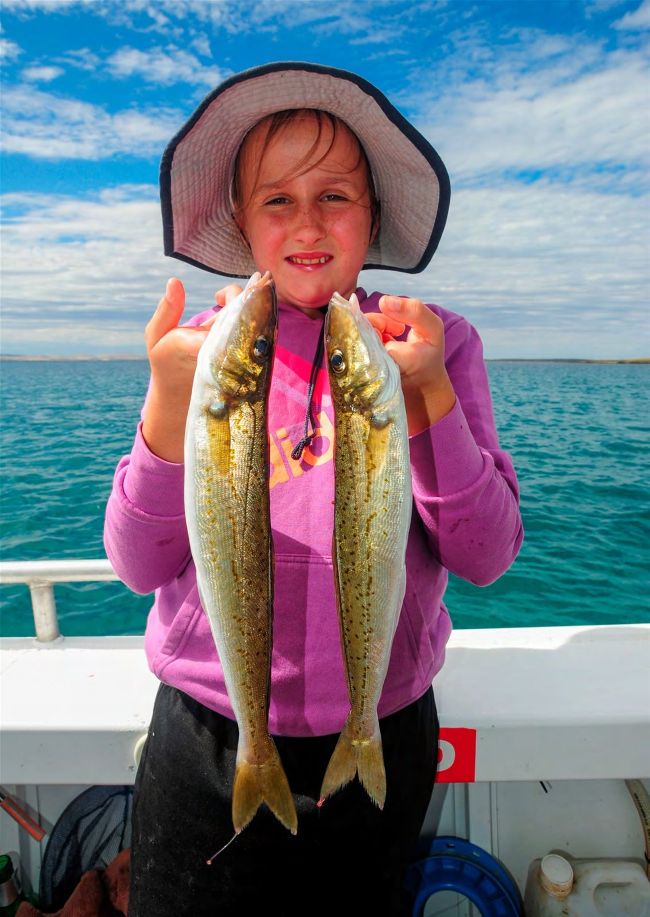
Eastern Eyre Peninsula is a great area for whiting
Aside from blue crabs, a few King George whiting can be found within this shallow bay, but not in the numbers nor size found outside of the harbor at other nearby locations. Trumpeters can also be a nuisance during the warmer months inside the harbor, but they make handy crab bait. Trolling 60-80mm diving hard body lures around the channel edges can be effective on salmon trout and snook. During the summer months small bronze whalers – mainly under 4ft – push into the warm water inside the bay and can offer some light tackle fun.
For the land-based fisher Cowell boasts some great wading for yellowfin whiting during the winter months. Wait for the incoming tide and walk the shallows with a pair of waders, looking for fish flicking in the shallows. You’ll also see patches of grey sand where the yellowfin have fed, which is always a sure sign that you’re in the right neighborhood.
Baits of seaweed worms and green prawn are effective for the Franklin Harbor yellowfin. Try fanning casts in front of your walking direction and slowly retrieve as you make your way along the shallow shoreline. Once you find some fish, invest a bit of time in that area before you start walking on again. And proceed cautiously, as these yellowfin often push into surprisingly shallow water and can spook easily.
Raking for blue swimmer crabs is another popular land-based option through the shallow water of the harbor. Aim to work the edges of the weed line on low tide, and slowly follow the tide in. Remember when chasing blue swimmer crabs to check all females for eggs, and return them if they are ‘berried’. We mainly see berried females at the beginning of the season.
The Cowell jetty is another land-based option within the Harbor. Tommies and snook can be caught from the jetty, especially from around the lights at night. The base of the jetty also offers a few yellowfin whiting, but the size can be on the smaller side. There are a couple of marine park sanctuary zones within the Harbor which limits fishing access. These are on the eastern side of the harbor, and for full maps go to https://www.marineparks.sa.gov. au/maps-and-coordinates to see the boundaries of the Franklin Harbor Marine Park.
PORT GIBBON
Port Gibbon is a small shack community in between Cowell and Arno Bay. To get there, turn off the highway 15km south of Cowell, where you will follow a dirt road for 7km before arriving at Port Gibbon. Enroute you will drive past the Port Gibbon Igloos, which are dotted throughout the roadside paddocks. These are concrete air raid shelters which were constructed in 1942 when Australia feared Japanese invasion during the Second World War. They were constructed to help safeguard the strategic ports of Whyalla and Port Pirie, but were never used as peace was declared shortly after their construction.

Franklin Harbor is a blue crab Mecca
Port Gibbon comprises 30-odd shacks, along with the remains of the old Port Gibbon jetty. There are several camping areas along this coastline where you can pitch camp for $10 per night or $50 per week. But there are no amenities within Port Gibbon so you will need to be self-sufficient. Bookings for these campgrounds can be made on line.
There is vehicle access onto the beach at Port Gibbon where boats can be launched, but this is a basic beach launch, so you will need to pick the conditions. The boat fishing out from Port Gibbon can be really good, with a mixture of whiting, snook, red mullet and calamari. The King George are typically good size, but they can be quite ground specific so you will need to move around until you locate some fish if you are unfamiliar with the area.
For the land-based fisher some nice yellowfin whiting can be caught on the shallow beaches around Port Gibbon, especially to the north around The Knob and Flat Rocks. A couple of kilometers to the south of Port Gibbon is Mills Beach, which sits on the southern side of Point Price. Salmon trout can be caught along Mills Beach, along with some nice bronze whaler sharks during the warmer months.
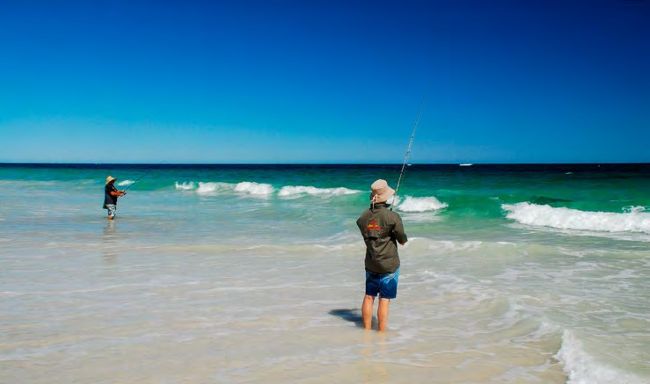
The beaches from Cowell to Arno Bay offer some great yellowfin whiting fduring the warmer months
ARNO BAY
The next township south of Port Gibbon is Arno Bay. With a population of approximately 300 people, Arno offers basic amenities such as a supermarket, pub, caravan park and cabins, but unfortunately no fuel in Arno Bay, with Cleve being the closest fuel station at 26km away.
Arno Bay rose to fishing fame during the mid 2000s when the local snapper scene was revealed. It seemed like every TV fishing personality visited Arno Bay during those peak years, showcasing the local snapper fishing. And the fishing was amazing, mainly in the deeper offshore Gulf waters, but this fishery sadly succumbed to pressure and the numbers were in obvious decline by the time the extended snapper ban came into play.
There are some really good boat fishing and land-based fishing options along the Arno Bay coastline. For the boat fisher there is a well-maintained all-weather launching facility within the breakwater groin, and while the ramp is protected from the wind, there can be a bit of surge pushing up the concrete ramp, so take care.
Summertime sees persistent south-easterly winds pushing off the water and onto land, creating quite choppy conditions most afternoons. It’s a good idea to fish early in the day during the warmer months to avoid the sea breezes. The nearby wind farms are an indication of the localised wind.
From the boat ramp breakwater and pushing down to south point, some nice size calamari can be caught in the bay by drifting over the sea grass meadows and working squid jigs. These calamari can be patchy, but when you find one, you’ll generally find a small school, so make sure you cast a secondary jig behind any hooked calamari. Similarly, trolling hardbody diving lures in the 60-80mm size through the bay accounts for some nice snook, especially from January through until March.
There are plenty of whiting grounds around Arno Bay, with the misery grounds to the north (out from Poverty Bay) some grounds right in front of the township, and then some grounds to the south, which tend to fire up in the winter months. Most of the whiting grounds are in the 8-12m depth range. And similar to Port Gibbon, the King George are generally good-sized fish, but they can be localized, so you may need to keep on the move to locate some fish. There is plenty of inshore limestone along this whole stretch of coastline which holds some silver trevally, plus big silver drummer and King George. The whiting are rarely found in big numbers around these inshore slabs of reef, but they are usually 40cm-plus fish.
When I lived in Arno Bay we used to spend plenty of calm summer evenings drifting shark baits out wide. This coastline sees quite a few hammerhead sharks and mid-sized bronze whalers when the water starts to warm from November onwards, which offer plenty of fun on light to medium tackle. We used to motor a kilometre or two straight out form the ramp, set up a berley trail together with some tuna oil and deploy some baits under balloons while slowly drifting.
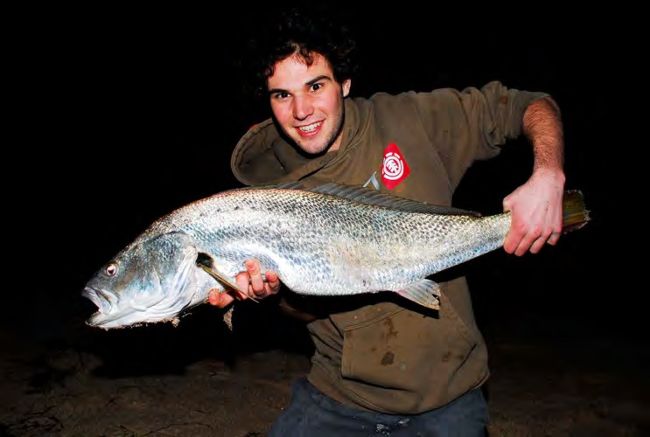
The Arno beaches produce school mulloway after dark
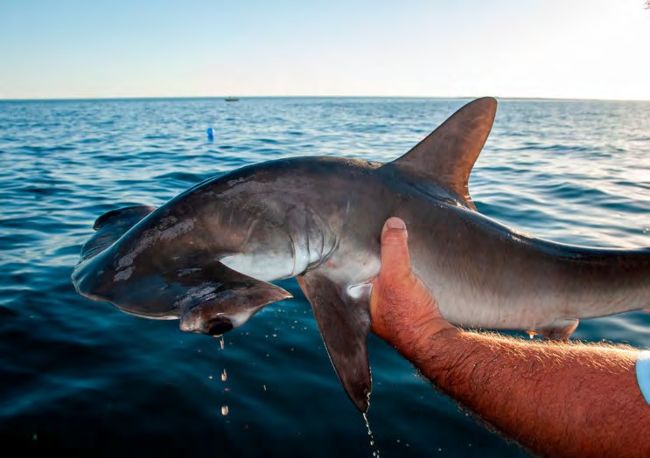
Small hammerheads are common on hot summer days
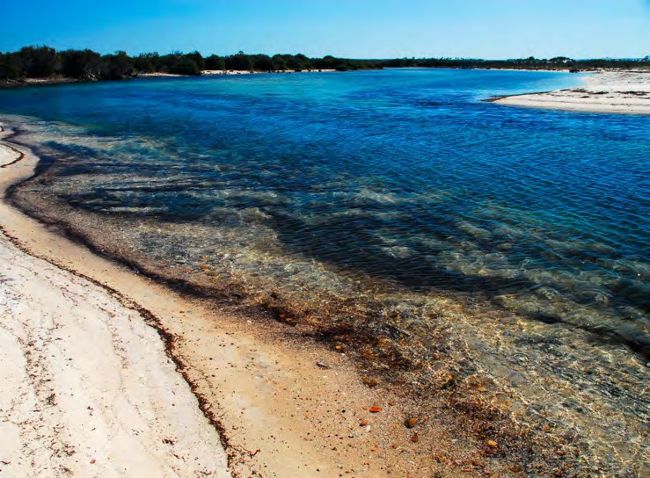
The creek at Arno yields yellowfin, salmon trout and mullet
There are some good shore-based fishing options around Arno Bay too, with the nearby creek system a good starting point. Yellowfin whiting can be caught around the mouth of the creek, especially from December through until March, along with some nice mullet, salmon trout and even the occasional salmon in the deeper holes of the creek system. There is a terrific boardwalk taking you through the mangrove forest, with fishing stations dotted periodically along its length. The creek is fantastic for kayak fishing too.
Fishing from the breakwater rocks offers some nice calamari, especially during westerly winds, and so too the jetty from the mid section and out towards the end. Casting and retrieving slow sinking squid jigs is the best approach, but setting a jig under a float can also be effective. The jetty also offers a few snook and tommies under the lights at night, especially when the water is clean.
Arno Bay actually collects a bit of ground swell when the direction is quite southerly. The swell just misses The Group out from Tumby Bay and funnels up the gulf to hit the beaches on either side of Arno Bay. This swell helps to create some nice sand formation and deeper holes along a few of the beaches, where a few school mulloway can be caught. Fishing fresh baits around the top of the tide and during rough conditions was when we saw the bulk of our action. These fish required plenty of time and effort, but we got some lovely chromed mulloway up to 13kg from these beaches, with most fish in the 70 to 90cm size range.

The author’s dad, Peter, with a lovely KG
PORT NEILL
This beautiful seaside town is set on the shores of Mottled Cove, and has to be the most picturesque bay along this whole stretch. With the cove’s orientation facing the north-easterly quarter, the water is typically calm and clear for most of the year. Port Neill is only a small settlement, with a permanent population of under 200, but this number swells over the summer months as the seaside shacks fill with holidaymakers.
There are very few amenities in Port Neill, but there is a well serviced general store, which also supplies fuel. There is a caravan park in the township, but at the time of writing the pub had temporarily closed – hopefully to reopen again soon.
There is an all-weather dual lane ramp on the southern side of the shacks for boats of all sizes. King George are the number one target in town, with the popular grounds of The Uncles and Cox’s to the north of the township. Most of the whiting grounds are set away from the shoreline in 10m of water, so once again you’ll be relying on your sounder, or some guidance from a local to find the grounds.
To the south of Port Neill is the golf course and a couple of small low-lying rocky islands set a shore distance from the shoreline. On a windy day tucking on the inside of these islands can offer the only protection for a boat fisher along this stretch of coastline. The water is shallow through here, but a surface berley will attract some garfish and tommies to your area. The deeper sand holes on the outside of these islands can produce a few good sized King George.
Land-based fishing is popular around Port Neill, with the local jetty offering some good calamari, garfish and tommies, along with a few snook on lures. I’ve never done any good chasing King George from the jetty due to the lack of sand holes, but there are plenty of leatherjackets and trumpeters.
Yellowfin whiting can be caught from the beaches around Port Neill during the warmer months, with Cox’s Beach, Burns Beach, Carrow Wells and Cowleys Beach all offering some nice yellowfin in the shallows. Try to avoid fishing these beaches during the stiff summer south-easterlies as the fishing can be tough with stirred up inshore water. Instead, wait for cleaner conditions.
Carrow Wells also offers a few small salmon, with fish up to around a kilogram frequenting the beach and the rocky headland at either end. There are some nice flathead along the beaches to the south of Port Neill, too. Try casting paddle tail soft plastics around scattered rock along these sandy stretches, especially around the high tide period. There are some nice rock platforms to the south of Port Neill as well, and fronting deeper water, they offer some good rock hopping for a range of species.
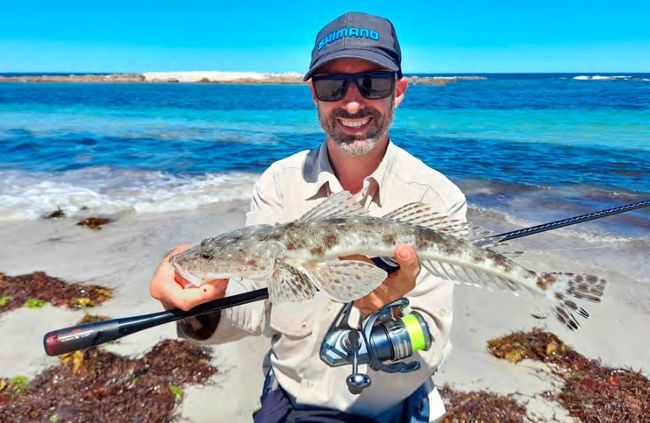
Nice flatties are always a chance on the Port Neill beaches
As you can see, there are plenty of fishing options to keep you occupied along the eastern Eyre Peninsula, with lots of beautiful beaches and coves to explore. And the highlight is you’ll invariably be enjoying this coast with very few others!